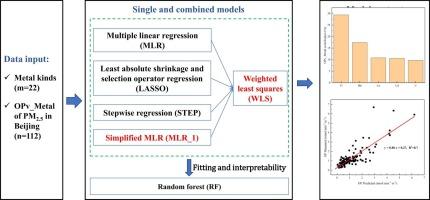北京PM2.5二硫苏糖醇氧化电位(OP):金属对OP的定量贡献及其基于机器学习模型的预测
IF 11.3
1区 环境科学与生态学
Q1 ENGINEERING, ENVIRONMENTAL
引用次数: 0
摘要
大气细颗粒物(PM2.5)通过活性氧(ROS)引发的氧化应激对健康产生不利影响。氧化电位(OP)是反映PM产生ROS和消耗抗氧化剂能力的一个化学参数。本研究采用二硫苏糖醇(DTT)法测定OP活性(简称OPDTT)。一些氧化还原金属已被证明具有很强的OPDTT活性。然而,用化学方法估计PM2.5中每种金属对OPDTT的贡献是具有挑战性的。本文基于北京市数百个PM2.5样本,利用机器学习模型,提出了22种金属/类金属对OPDTT的定量贡献和排序。在几种组合模型中,多元线性回归(修正版)和加权最小二乘模型的组合是最有效的。结果表明,除了锰、铜等众所周知的金属外,一些不太为人所知的金属也做出了重要的贡献。本文提出的模拟结果涵盖了大多数金属对OPDTT的贡献,有助于全面了解PM2.5对健康的影响。本文章由计算机程序翻译,如有差异,请以英文原文为准。

Dithiothreitol oxidative potential (OP) of PM2.5 in Beijing: quantitative contribution of metals to OP and its prediction based on machine learning models
Atmospheric fine particulate matter (PM2.5) has been acknowledged to exert adverse health effects through reactive oxygen species (ROS) initiated oxidative stress. Oxidative potential (OP) is a chemical parameter that reflects the abilities of PM to generate ROS and deplete antioxidants as well. Dithiothreitol (DTT) method was used in this study to measure the OP activity (described as OPDTT). Some redox metals have been demonstrated to possess strong OPDTT activities. However, it is challenging to estimate the contribution of each metal in PM2.5 to OPDTT by chemical method. In this study, the quantitative contribution and ranking of 22 kinds of metals/metalloids to OPDTT were proposed by means of machine leaning models based on hundreds of Beijing PM2.5 samples. Among several combined models, the combined multiple linear regression (modified version) and weighted least square model emerged as the most effective. It was revealed that not only well-known metals such as Mn and Cu were important, but also some less-recognized metals like Tl made significant contributions. The modeled results presented in this paper encompass the contributions of most metals to OPDTT and are conducive to a comprehensive understanding of the health effects of PM2.5.
求助全文
通过发布文献求助,成功后即可免费获取论文全文。
去求助
来源期刊

Journal of Hazardous Materials
工程技术-工程:环境
CiteScore
25.40
自引率
5.90%
发文量
3059
审稿时长
58 days
期刊介绍:
The Journal of Hazardous Materials serves as a global platform for promoting cutting-edge research in the field of Environmental Science and Engineering. Our publication features a wide range of articles, including full-length research papers, review articles, and perspectives, with the aim of enhancing our understanding of the dangers and risks associated with various materials concerning public health and the environment. It is important to note that the term "environmental contaminants" refers specifically to substances that pose hazardous effects through contamination, while excluding those that do not have such impacts on the environment or human health. Moreover, we emphasize the distinction between wastes and hazardous materials in order to provide further clarity on the scope of the journal. We have a keen interest in exploring specific compounds and microbial agents that have adverse effects on the environment.
 求助内容:
求助内容: 应助结果提醒方式:
应助结果提醒方式:


